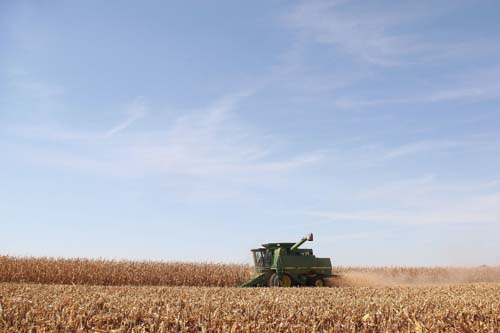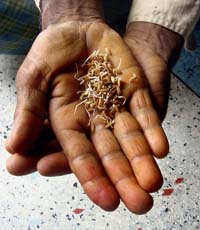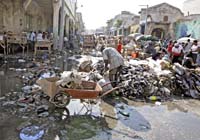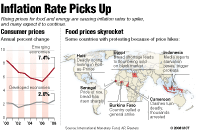 Getty Images
Getty Images
Article
Rising food prices—failing crops—starving citizens turning to riotous violence—governments and leaders scramble to find solutions. A crisis of biblical proportions has slammed into nations around the world, affecting rich and poor alike. Could this have been foreseen? What can be done to stop it?
Learn the why behind the headlines.
Subscribe to the Real Truth for FREE news and analysis.
Subscribe NowA middle-aged farmer surveys his fields, square patches of differing hues of green, as the sun creeps toward the dark blue mountains on the horizon. He checks on his water buffalo and sets his sights on his hut in a small village, many miles from the nearest city. As he approaches home, he can smell the evening meal and hear the pleasant sounds of his small family. Later, while drifting off to sleep, he thinks of the planting season coming in only a few weeks.
In less than 24 hours all of this is gone—the area in Myanmar decimated by the 120 mph winds of Cyclone Nargis.
The farmer looks out at his flooded fields, his life in ruins. His family is either dead or missing, as are his livestock, and lost are the seed for the upcoming crop season and food stores from the spring harvest. His future swept away in a 12-foot tsunami-like storm surge.
He stares, exhausted, at the heap of vegetation that was once his home. He is only one of five people left in his village, where there were once 200. Bodies of the dead are everywhere, grasping hands reaching out from the floodwaters. The future is bleak.
But there is a more pressing need—he has no food to survive.
Cyclone Nargis created an immediate crisis. The worst hit was the Irrawaddy delta region, also known as Myanmar’s Rice Bowl, which produces 65% of the nation’s rice. The cyclone put nearly two million people in need of immediate aid. Satellite images showed the area was utterly inundated; the lush, green delta, which once had winding rivers, now bore the likeness of tiny islands in the ocean.
 STR/AFP/Getty Images
STR/AFP/Getty Images
 Miami Herald/MCT
Miami Herald/MCT
 Getty Images
Getty Images
Aid agencies scrambled to avert an even broader crisis: missing the next harvest. They located new pigs, ducks and chickens, and researched rice seeds from Thailand capable of standing up to the salt water brought ashore with the storm surge. In lieu of immediately replacing Myanmar’s 149,000 draft buffaloes, aid agencies began buying up new Chinese-made tractors, or “iron buffaloes,” to assist with the upcoming harvest. Fields would have to be drained, ruined irrigation systems fixed.
The deputy country director for the World Food Programme (WFP) in Myanmar, Hakan Tongul, said just days after the cyclone that 50,000 tons of rice would be needed to feed survivors for the next six months. He only had 3,000 tons at hand.
“I think we’re going to miss it, we’re going to miss the harvest,” he said. “Time is short.”
Mr. Tongul estimates that, if the WFP is unable to deliver supplies on time, and the window for planting is missed, 50,000 additional tons of rice will be required.
Also, experts project that a missed harvest will lead to a further strain on the world’s food supply.
Sadly, the above example is just one of many localized crises making up the current global food crisis. Similar accounts could be recorded of malnourished Cambodian children, the millions starving in Ethiopia, Somalia and nations throughout Africa—the list could go on.
Even before Cyclone Nargis made landfall in Myanmar, an international food crisis was already looming. In April, the WFP said global increase in food prices is creating “the biggest challenge” it has faced in the organization’s 45-year history—what the WFP terms as “a silent tsunami threatening to plunge more than 100 million people on every continent into hunger.”
“The New Face of Hunger”
After returning from Myanmar (also known as Burma), Henrietta Holsman Fore, Director of U.S. Foreign Assistance and the U.S. Agency of International Development Administrator, said, “The catastrophic cyclone in Burma, hitting that country’s major rice producing region in the middle of the rice harvest, is a reminder of the fragile food situation we face in many developing countries.
“We are in the midst of a global food crisis unlike other food crises we have faced, one not caused simply by natural disasters, conflict or any single event such as drought. It is not localized—but pervasive and widespread, affecting the poor in developing nations around the world.”
She pointed out that the international food price index rose 43% in 2006, immediately affecting the world’s poor the worst. “For our poorest one billion, living on just a dollar per day, very high food prices mean stark choices between taking a sick child to the clinic, paying school fees, or putting food on the table.”
The WFP estimates that one billion of the world population subsists on less than a dollar per day. Of these, 162 million live on less than 50 cents per day. These households generally spend 50-60% of their income on food.
Meeting with the British government in April, WFP Executive Director Josette Sheeran described the millions now priced out of the food market as “the new face of hunger.” Within the last six months, price increases have left millions in urban areas around the world hungry, unable to afford rising grocery store prices.
In February, WFP announced a $500 million deficit in its budget, and urged wealthy nations to increase contributions. In April, Ms. Sheeran announced that the gap had risen to $755 million. At that time, she said the WFP was “putting out an urgent appeal for the world to help us meet not only our base budget to meet the accessed needs of people from Darfur to Uganda to Haiti and beyond, but also to meet this gap.”
Unless that money is pledged, the WFP will be forced to scale back many of its humanitarian assistance programs.
To make matters worse, food commodity prices continue to rise. With each passing day, aid agencies—and individuals—are able to buy less food with each dollar.
In response to the request for funds, the U.S. government, which contributes half of all global aid, gave an additional $200 million to the WFP. (President George W. Bush has asked the U.S. Congress to approve an additional $775 million for food aid for 2009.) Also, the British, Spanish and German governments have promised more assistance. The European Union has also approved $183 million to help fight the crisis.
Results of the “Perfect Storm”
This “new face of hunger” has a violent side. In cities across the globe, riots are breaking out. As Josette Sheeran put it, “A hungry man is an angry man.”

Last month, at least six protesters died and 268 were injured in food-related riots in Haiti. In one episode, protestors looted shops and fired on UN peacekeepers, damaging a UN gate. During the past year, the island country has seen a 50% increase in food prices of staple items, including rice, beans and fruit. The Haitian prime minister was pressured to resign after being unable to deliver food to the increasingly discontented public.
Food riots have also occurred in Morocco, Yemen, Mexico, Guinea, Mauritania, Senegal and Uzbekistan. All together, an estimated 33 nations are at risk of violence due to rising prices.
Also, major grain exporters such as China and India have put limits on grain exports to ensure their citizens will have enough to eat.
Blame for the food shortage and price hikes varies, with most saying it is a tangle of differing causes, from rising energy and fuel costs to climate change.
“There is a perfect storm that has emerged over this issue, a combination of factors: high fuel prices, high food commodity prices driven by the growth of economies in China and India, and then this phenomenon of biofuel production, where fields that were once used to produce grain for human consumption are now producing grain for fuel,” Greg Barrow, London spokesman for the WFP, told ABC News.
While stormy weather patterns have wreaked havoc on harvests across the world, excessive droughts in areas typically considered “bread baskets” are also affecting crop yields. Australia, normally the number two exporter of wheat, is experiencing its worst drought in 100 years. The nation’s wheat stocks are at their lowest level since 1979.
Additionally, world stores of wheat are expected to dwindle to 110 million tons by the end of May, the lowest since 1978, according to the USDA—with 2.3 billion more mouths to feed today.
With a booming population, the world must produce more food. But, adding to the demand, many developing nations are adopting meat-heavy Westernized diets, consuming more grain. For every 100 calories of beef, it takes about 700 calories worth of grain to feed cattle.
Record high oil prices mean that all shipping costs are up. It also means that fertilizers and pesticides are more pricey.
In the race to limit the West’s reliance on petroleum based oil, many governments plan to produce more biofuels. However, biofuel production is now seen as a large factor in the current crisis. It has been estimated that to produce about 13 gallons of biofuel, 511 pounds of grain are needed—equating to enough food to feed a child for a year!
“Unlike Other Food Crises”
The United Nation’s top food adviser, Olivier de Schutter, told French newspaper Le Monde that the “era of cheap food is over.” He blamed the shortage on “20 years of mistakes” by organizations and governments around the world. He also said the current troubles were predictable and that failure to anticipate today’s conditions is “unforgivable.”
 Getty Images
Getty Images
However, the present mess of problems affecting mankind is the result of much more than 20 years of mistakes—as these problems have always been with man and ever worsening. But, Mr. de Shutter is right; these could have been—and were!—predicted.
Experts have long projected that a booming population would soon lead to food supply problems. Until now, those words have gone unheeded.
In the 1960s and 70s the “Limits to Growth” camp said the global population would soon surpass the earth’s ability to sustain it—farmland and resources would be stretched thin and run dry. These predictions were viewed as being alarmist and no one heeded them—until now.
But the current food predicament is rightly called “a crisis unlike other food crises.” Something on this scale has never before been seen.
No food means violence! It means civil unrest! People want answers and they are looking to their nations’ leaders, demanding action.
For now, there is seemingly only one solution—throw money at the problem. However, we are already seeing that food is available, but even aid agencies cannot afford it! What will happen when there is no longer enough farmland to feed every grumbling stomach?
Who is capable of answering that question? Brilliant scholars, scientists and experts—with the most knowledge man has ever accumulated!—cannot solve this problem. Man continues to haul famine around like a large iron ball chained to his leg. With only manmade solutions, the scourge of famine will continue to beleaguer the nations of earth.
Another source foretold—and poses the only solution to—today’s food crisis, and to most this source comes from an unexpected place.
While talking to His disciples, Jesus Christ foretold a time when “nation shall rise against nation, and kingdom against kingdom: and there shall be famines, and pestilences, and earthquakes, in divers [various] places” (Matt. 24:7). This was part of His answer to a question posed by His disciples: “What shall be the sign of Your coming, and of the end of the world [age]” (vs. 3)?
Again, famine has always accompanied the civilizations of men. So, when Jesus replied that “there shall be famines,” it would have to be a different and new kind of famine, such as never before seen in size and scale—a global food crisis!
Famines have generally occurred in localized areas. These “small fires” could be “put out” by wealthier nations giving of their excess. However, never before has man experienced the intricately interconnected world with a “perfect storm” of factors able to bring nations to their knees. And these conditions will only worsen. As shown before, man is incapable of solving this problem, just as the farmer mentioned earlier could not save his family or home from 120 mph winds.
However, this is all bad news. These end times, in which we are living, include increases in war, disease and natural disasters—all leading to an ever-worsening food crisis.
Recall, however, that when the disciples asked Jesus Christ when the end shall be, they also included “What shall be the sign of Your coming?”
The good news is that a global supergovernment, with perfect laws—a government not subject to the problems that have always plagued mankind—will be established at Christ’s imminent Return. That government—the kingdom of God—will replace all governments of men, tearing down their flawed and corrupt systems (Dan. 2:24). Finally, the ever-growing “tsunami” of man’s insoluble problems and troubles will cease!
More on Related Topics:
- More Aid Workers Have Been Killed in 2024 Than in Any Other Year, UN Says
- Vladimir Putin Touts Russia’s New Missile and Delivers a Menacing Warning to NATO
- Top War-crimes Court Issues Arrest Warrants for Benjamin Netanyahu and Others in Israel-Hamas Fighting
- Thousands of North Korean Troops in Russia. What Does That Mean for the War with Ukraine?
- Why the Olympics Can’t Unite the World


